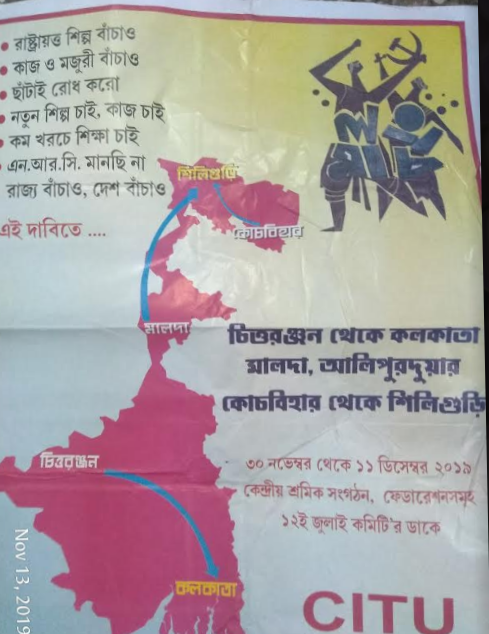Workers Gear up for ‘Long March’ in West Bengal From November 30

Kolkata: Workers across sectors in West Bengal will undertake a 283-km ‘Long March’ from November 30 to December 11, with the aim to unite movements against the government’s anti-labour and pro-corporate policies and to ‘save the public sector’.
Kicking off from Chittaranjan, the township known for Indian Raliway’s Chittaranjan Locomotive Works, the march will end in Kolkata on December 11.
Led by the Centre of Indian Trade Union (CITU), the ‘Workers’ Long March’ plans to step up and unify protests to save India’s public sector units, most of which are on the block of disinvestment by the Centre, among other demands.
“At the start of this neoliberal economy (in the early 1990s) there was a lull in worker movements because people did not understand its long-term ill effects. The ripples are being felt right now,” senior CITU leader Shyamal Chakraborty, told NewsClick.
The ‘Chittaranjan To Kolkata’ march will be supplemented by marches from Malda to Siliguri and Cooch Behar to Siliguri from November 30 to December 11.
Chittaranjan Locomotive Works, once known as one of the best performing public sector undertakings (PSUs), is now in a beleaguered condition due to the Narendra Modi-led Bharatiya Janata Party (BJP) government’s efforts to disinvest PSUs or close down many units.
The ‘Workers’ Long March’ is aimed to create awareness among people on the importance of a strong public sector and against the anti-people policies of the government, said CITU sources.
The central trade union leaders said even though the Supreme Court and various High Courts have given many verdicts in favour of workers, but a ‘strong people’s movement’ is needed to get these implemented, said Chakravarty, adding that this is because “the government is driven by capitalists.”
It needs strong political will and people’s movements to ensure implementation of a passed law, he said, citing the example of Barga (share-cropper) law, which was passed by the Congress government in West Bengal, but was enforced only after a strong peasant movement grew backed by the United Front and then by the Left Front government.
Forging strong movements was the only way out to win workers’ demands, such as equal pay for equal work, minimum wage of Rs 18,000/month, he said.
Charavarty said there were several movements going on across sectors in the state, such as those by para teachers, Central project teachers, among others.
According to CITU, the proposed ‘Workers’ Long March’ plans to reach every factory gate and grassroot workers in West Bengal, as well as the unorganised sector.
As of now, the Modi government has also decided to disinvest the profitable Bengal Chemicals, Alloy Steel, Chittaranjan Locomotive Works, Bridge and Roof , Railway printing press, Santra Gachi Government Press, coupled with banking sector and the telecom majors, such as BSNL and MTNL. Government ariline, Air India, is already in disinvestment mode.
In sectors, such as defence, Railways and coal, the government is aiming for 100% privatisation in principle.
Banking sector officers and employees will be standing on both sides of road and highways as also intersections to greet the ‘Workers’ Long March’ participants, Sudipta Saharoy, one of the key organisers in the banking sector, said.
Get the latest reports & analysis with people's perspective on Protests, movements & deep analytical videos, discussions of the current affairs in your Telegram app. Subscribe to NewsClick's Telegram channel & get Real-Time updates on stories, as they get published on our website.
























